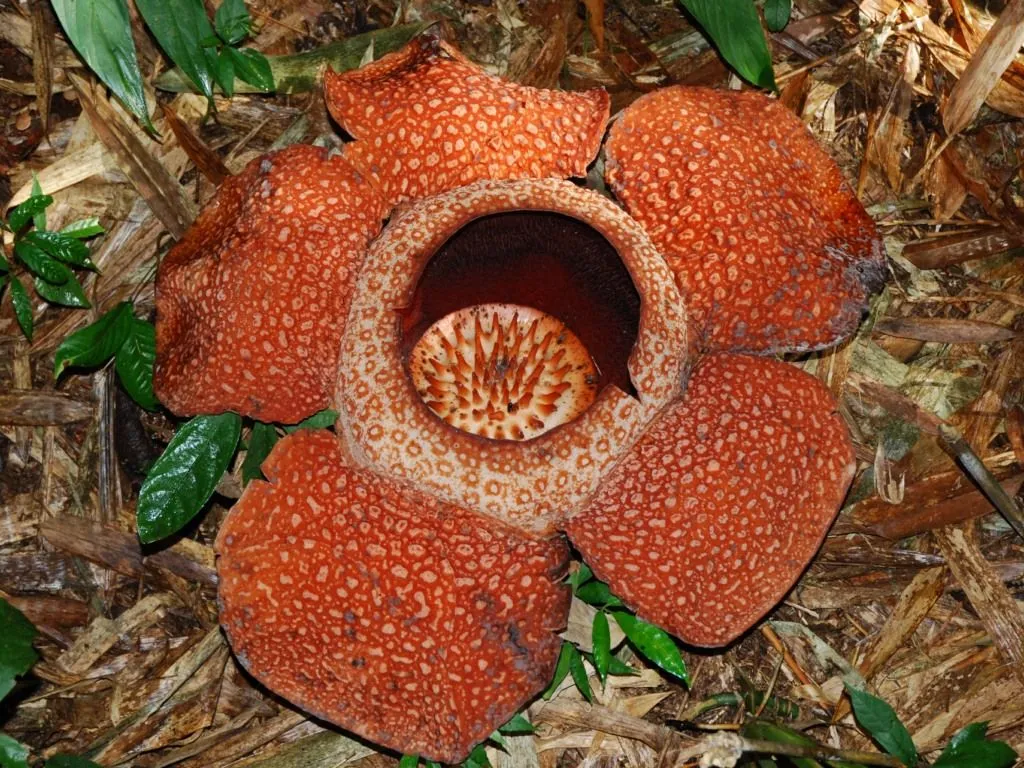Rafflesia

The largest flower or Rafflesia is a genus. It is a genus of the parasitic flowering plant. You can found this flower species mainly in Asia in the country like Malaysia, Indonesia, Thailand, and the Philippines, for your information, this largest flower contains around 28 species of them. There is much research abbout this parasitic flowering plant because of their unique appearance. Why is it unique? This plant has no leaves and also there no stem to support them. But, although they have no leaves and proper root, they have their special structure which it uses to penetrate the cells of their host, the structure known as Haustoria. They are not using their special structure to penetrate to their host cells only and clung to them, but they also will steal nutrient and water from their host. One of the species known as Rafflesia Arnoldii it is so big, its diameter can be almost a meter with 10kg weight and there also a small species known as Rafflesia Baletei it has the only 12cm diameter. For this reason, that’s why this plant is known as the largest flower in the worlds. This plant is very short life and it also hard to find them.
It has their own local name, “Meat Flower” people call them as a meat flower because of their look and smell like rotting flesh. But, it there is the reason why they release the foul odor, they release the bad smell because they want to attract the insect. The insect will help them to transfer their pollen from the male flower to the female flowers. A few of them, there also have Hermaphroditic flower, which has both female and male sex organ and another sexual characteristic. For your information, this larger flower is remarkable, this is because of a large horizontal transfer of genes from their host plants. Large horizontal transfer of genes actually well known among bacteria and not on the others higher organism. This parasite plant was evolved from the photosynthetic plants of the order Malpighiales, this was indicated when the sequence of mitochondrial DNA(mtDNA) is compared with the others angiosperm mitochondrial DNA(mtDNA). Malpighiales is the largest order of the flowering plant, for your information, there are 16000 species of the Malpighiales. There are much research about rafflesia some researchers are using mtDNA and nuclear DNA sequence and it results 3 other groups traditionally classified in the Raffleasiaceae were unrelated. There also study found that Rafflesia and the others it relative is in the Euphorbiaceae family. A lot of study by the researcher do in this species.
R. Arnoldii, R. Cantleyi, R. Pricei and R. Tengku-Adlinii is the species that native to Borneo. For your information, R. Arnoldii is the world’s largest flower or the world largest single bloom, R. Keithii is an endemic Borneon species, this species will start to bloom at night and it will take 2-3 days later to decompose back. About 6 to 9 month for the bud emerge into flowering. And to make sure the pollination occurs properly, the male flowers and female flowers must be open simultaneously. Actually, the successful pollination and the fruit production is rarely succeeded. That’s why these species are endangered it is because of the limitation of the reproduction. Thanks for reading and keep following My Biologist's Adventure.
Reference
1. Shaw, Jonathan (March–April 2017). "Colossal Blossom: Pursuing the peculiar genetics of a parasitic plant". Harvard Magazine. Retrieved 27 June 2017.
2. "Where to see Rafflesia in Thailand – the biggest flower in the world". 203 Challenges.
3. Barkman, T. J.; S.-H. Lim; K. Mat Salleh; J. Nais (January 20, 2004). "Mitochondrial DNA sequences reveal the photosynthetic relatives of Rafflesia, the world's largest flower". PNAS. 101 (3): 787–792. doi:10.1073/pnas.0305562101. PMC 321759 Freely accessible. PMID 14715901.
4. https://en.wikipedia.org/wiki/Rafflesia
5. Nickrent, D. L.; A. Blarer; Y.-L. Qiu; R. Vidal-Russell; F. E. Anderson (October 20, 2004). "Phylogenetic inference in Rafflesiales: the influence of rate heterogeneity and horizontal gene transfer". BMC Evolutionary Biology. 4: 40. doi:10.1186/1471-2148-4-40. PMC 528834 Freely accessible. PMID 15496229.
6. Davis, C. C.; M. Latvis; D. L. Nickrent; K. J. Wurdack; D. A. Baum (January 11, 2007). "Floral gigantism in Rafflesiaceae". Science. 315 (5820): 1812. doi:10.1126/science.1135260. PMID 17218493.
7. "Rafflesia Facts - Rafflesia, The World's Largest Bloom". RafflesiaFlower.com. Retrieved 14 September 2016.
SteemSTEM Community
This one also I love to write also guys. SteemSTEM is a community in Steemit, I am very proud with this community because @steemstem is encouraging people like me to promote and write about Science, Technology, Engineering and Mathematics(STEM) postings on Steemit.Because of this also important things that we should know as our additional knowledge. If you want to post about , Science, Technology, Engineering or Mathematics please don't forget to add #steemstem at your tag .
Join and learn about the project , Join us on steemit.chat:
(https://steemit.chat/channel/steemSTEM)
